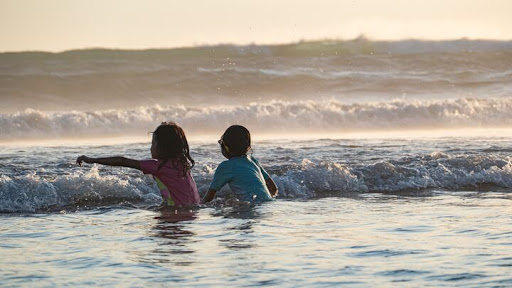Écrit par: Lindsay Peltsch Infirmière autorisée, B.Sc.Inf.
Contributions de : Dr Harley Eisman MDCM, FRCPC
Drowning. The word itself is charged and creates a visceral emotion for most parents. As pediatric nurses and doctors (who are also parents), we have seen this tragedy firsthand. We understand the very real fear of your child drowning, and don’t want it to become a reality for anyone. Our responsibility in frontline healthcare is to not only treat illnesses and concerns as they arise, but to PREVENT things before they happen though education. In pediatrics, we have a powerful ally that no other area of medicine has…you!. Parents and caregivers are an advocate group like no other, eager to work as a team to prevent harm to their children. For us, it is tremendously rewarding to empower this team through education. Sometimes though, a healthcare provider’s well-intended explanation of an issue can take on a life of its own and accidentally cause panic among caregivers instead of empowerment. Examples of this are the terms “dry drowning,”, or “secondary drowning.”
Un article sur “secondary drowning” ou “dry drowning” a commencé à faire son tour dans 2017. It detailed the terrible stories of children that had a fairly normal day at the pool or beach, spluttered after going under once, but returned home seemingly well. In the hours following, they became progressively sicker, and died. Losing your child is every parent’s biggest fear, but the added terror of potentially missing the warning signs when you think they are ok? New parenting fear unlocked. For most parents, it is easy to think back to the times your own child has choked on a mouthful of water, recovered, and ultimately carried on with their day. When you can personalize a tragedy, the fear grows deep roots in our psyche as parents. It’s difficult to overcome once it takes hold.
“The term secondary drowning or dry drowning should not be used, as it is a misnomer, and causes undue anxiety for parents and many unnecessary visits to the Pediatric Emergency Department” – Dr Harley Eisman
Cela a été largement documenté par pédiatres everywhere that these two terms are not medical terms. The tragic scenarios depicted in the media are actually called an aspiration event. Certainly not anything to take lightly, but the term itself is enough to deflate the anxiety surrounding it. So we can learn what it is – and how to spot it. KixCare’s médecin-chef Dr Harley Eisman, travaille comme urgentologue pédiatrique depuis plus de 25 ans à l'Hôpital de Montréal pour enfants. Il se souvient du moment où ces articles ont commencé à circuler et où le terme a commencé à être adopté couramment. Lui et beaucoup de nos collègues pédiatres partagent leur frustration face à la façon dont ce terme a créé une augmentation de la désinformation parmi les parents inquiets.
Qu’est-ce que la noyade ?

Noyade is when a child breathes in water, and that water fills up the tiny sacs in the lungs (alveoli). When there is fluid in the sacs, normal exchange of oxygen and carbon dioxide can’t take place. Drowning doesn’t always mean death. The amount of fluid that fills the lungs will determine whether the child can exchange any oxygen. The more fluid they take in, the more likely there is to be a fatal outcome. This happens within seconds and minutes. It is why you must always watch children around water.
KixTip ! – If you lose track of your child during the day, even if you aren’t at the pool, the FIRST place you should check is any available water source (pool, lake, pond, bathtub). Littéralement, chaque seconde compte. The majority of children who drown are fully clothed, meaning they weren’t “swimming” when the event occurred. There are many other less obvious drowning risks that are part of our daily life. Head over to our Instagram to read more.
Si votre enfant subit un événement de submersion prolongé, nécessite une réanimation, perd connaissance et/ou a les lèvres bleues à tout moment, vous devez appeler le 911 ou vous rendre immédiatement aux urgences. Il s'agit d'un événement de noyade.
Qu’est-ce qu’un événement d’aspiration ?
Aspiration is a broad term for when any liquid or solid enters into the lungs. This can be anything from a drink like water, to food such as a popcorn kernel (more on that another day). However, there is always a risk of complications from aspiration, regardless of what substance is inhaled. In this case, we are talking about the aspiration of swimming water. The key to remember is that aspiration is our body’s reaction to a foreign substance in our lungs. Whereas drowning happens when water blocks the lungs’ ability to work.
Comment ça se passe ?
Our human bodies are amazing things. Since our lungs only like to have air in them, our body has many systems in place to keep everything else out. We have a flap (called the epiglottis) that automatically covers the entrance to our lungs when we swallow – think of it as a trap door.

IF something threatens to get past that trap door, our body has another defense – coughing! Have you ever had a sip of water “go down the wrong tube?”. Your body will cough forcefully – even until you vomit if necessary – to clear the perceived threat to the lungs. This may feel terrible, but shortly it passes. THAT is your amazing body doing its job, preventing aspiration!
However, when something sneaks past the epiglottis and gets into the lungs, it sits there over time and the lung tissue itself can become inflamed/irritated (swollen) or an infection can start. This doesn’t always happen right away, it progresses over time. This can cause respiratory distress, and can progress to serious complications left untreated. This is not as common as the news portrays, but there are always early symptoms to look out for in order to be safe.
Comment savoir quoi rechercher ?
Heureusement, ces symptômes sont faciles à repérer si vous savez quoi rechercher, et sont faciles à traiter lorsqu'ils sont détectés tôt. L’évaluation pédiatrique, c’est comme assembler les pièces d’un puzzle. Aucune pièce ne peut vous montrer l’ensemble du tableau. Au fur et à mesure que vous les assemblez, vous commencez à avoir une idée de ce que cela pourrait être. Bien que cela puisse prendre jusqu'à 24 à 48 heures pour qu'une image complète de l'aspiration émerge, les symptômes de petites pièces de puzzle se révèlent plus tôt. Ce sont les mêmes des principes que les pédiatres, les ambulanciers, les infirmières et les urgentistes expérimentés utilisent quotidiennement pour avoir une idée rapide de l'état de santé d'un enfant. Le secret d’une bonne évaluation pédiatrique est de continuer à la faire. Plus vous pratiquez, plus vous le ferez instinctivement et remarquerez de petits signes.
We created 3 easy-to-remember questions to identify those tricky puzzle pieces: the ABC’s of aspiration assessment
Comment va mon enfant UNça marche ? Comment va mon enfant Breathing? What is my child’s Ccouleur ?
- Si votre enfant semble bien et que vous répondez systématiquement NON à TOUS Questions ABC pour les 8 premières heures après un événement de submersion, ils iront probablement bien. Cependant, si quelque chose ne va pas, veuillez vous rendre aux urgences.
- Si tu réponds OUI à N'IMPORTE LEQUEL de ces questions à tout moment, même si tout allait bien auparavant ou si vous n'étiez pas au courant que cela s'est produit : Vous devez vous rendre aux urgences pour faire examiner votre enfant.

Aspiration events related to swimming are extremely rare. Using these three simple questions, you can be empowered to enjoy the water and trust your child’s body to tell you when something is wrong. By debunking the myth of dry drowning, we can promote effective water safety. Let’s prioritize education, prevention, and responsible supervision to create a safe environment where children can enjoy the benefits of water activities without unwarranted anxiety.

Si tu n'êtes pas sûr de votre évaluation, notre L'abonnement Kix360 vous permet d'envoyer des SMS à une infirmière pédiatrique expérimentée 24h/24 et 7j/7 sur demande. Ils peuvent discuter du scénario avec vous, faire une évaluation vidéo, vous aider à créer un plan et assureront un suivi régulier jusqu'à ce que votre enfant soit rétabli. Après tout, la tranquillité d’esprit n’a pas de prix.



